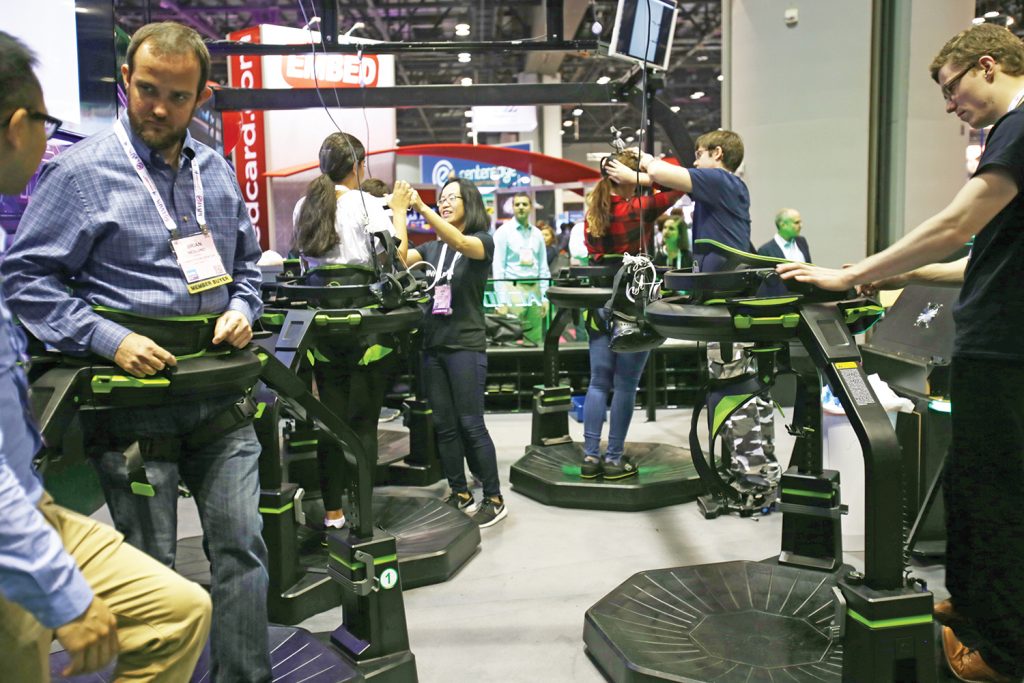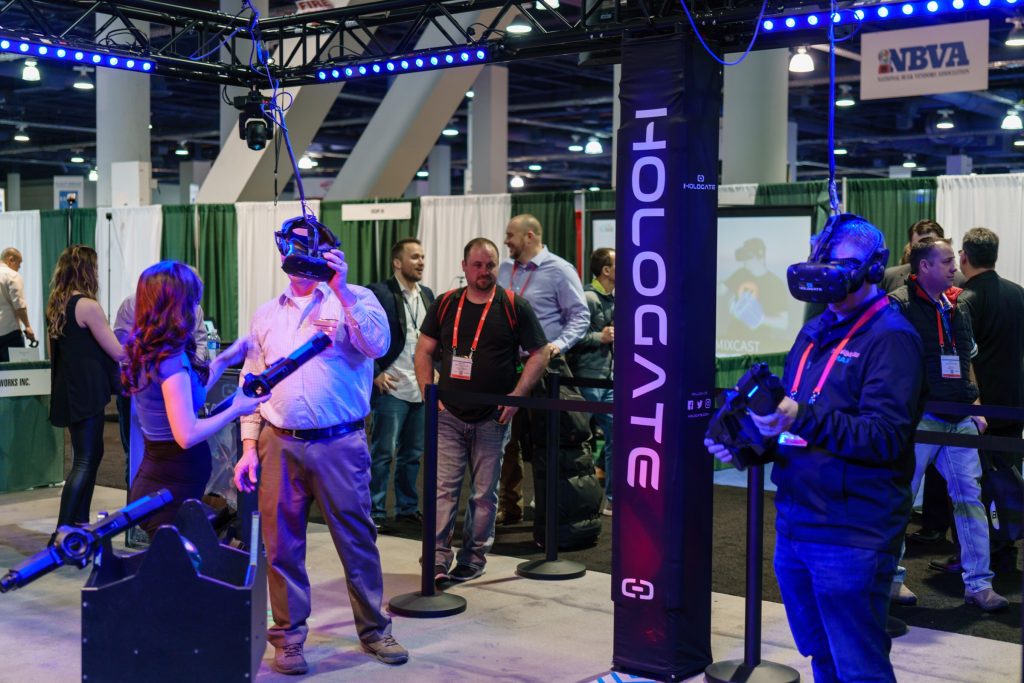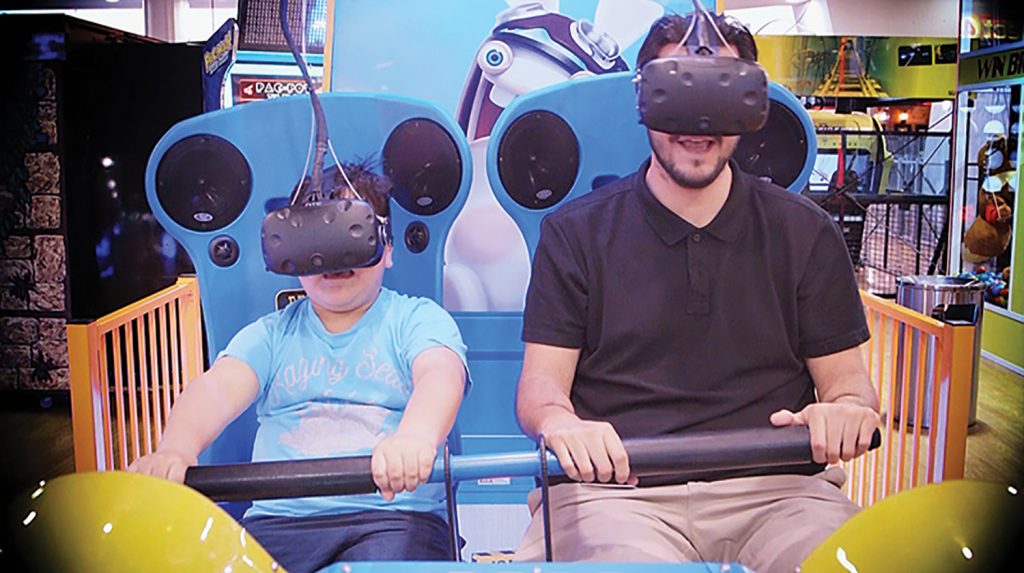What’s Hot…And What’s Not – Part Four
Using Game Trends & New Ideas in Promotions to Heat Up Revenues

by Frank Seninsky, President/CEO Amusement Entertainment Management (AEM) & Alpha-Omega Amusements & Sales
After attending the Amusement Expo earlier this year, it was very apparent that this industry has a keen interest in all things VR. Half the seminars were on the subject and drew a solid number of attendees. There were also seven or eight exhibiting companies showing their headsets, glasses, goggles, helmets, gear, VR apps, avatars, simulators, augmented reality applications and virtual life game technology on the show floor. This gave everyone an opportunity to see the beginnings of how VR can be used to make money in a typical family entertainment center as well as “on the street.”
I’ve been studying virtual reality hardware and available content for some time, evaluating various systems and looking at the important parts of the puzzle –– cost, space, player throughput, reliability –– to see how it fits into today’s FEC. (Check out the VR article on my blog for background at frank-thecrank.com/13-best-virtual-reality-youtube-videos-plus-article.)
As things stand today, I see a few main formats of VR that have emerged for the fun center market, many using off-the-shelf hardware such as Oculus Rift goggles.
The first is what I call a “donut”-type enclosure. The player steps into the play environment – a multi-directional treadmill with a ring around the perimeter to enclose the space –– and gets the attendant’s help getting the gear on and off. UNIS has developed a VR “open source” platform like this with its Omni Arena from Virtuix. (I first saw this at IAAPA 2017 where it drew a lot of attention.)

On one hand, UNIS’s open development platform is great for content, and the Omni Arena doesn’t take up a great deal of valuable real estate. On the other hand, the throughput is low since it takes a few minutes to get a first-time player geared up and checked out. Over time, we can assume players – and attendants – will be able to cut this time down, but I don’t think the throughput is where it needs to be just yet to attain my benchmark for revenue per square foot.

Another VR setup, the one I currently like best, is from Hologate in Germany, creatively marketed in the U.S. by Creative Works. The 4-player experience has a small-footprint (a minimum of 300 sq. ft. but most utilizing 400 sq. ft.). The players’ headsets are connected by cables that run overhead. Issues I’m concerned about include the cost of attendants helping the players, the reliability and replacement cost of the cables (potential breakage, etc.) and availability of future great content. On the upside, Creative Works is penetrating the market extremely well with, as I understand it, 20 to 30 installations out there already and close to a hundred pending. Creative Works gets a “thumbs up” for penetrating the FEC market so efficiently.
Virtual Rabbids (LAI) is Currently My Top VR Performer
Let me wrap this top-platform trend talk by covering LAI’s Virtual Rabbids. We’ve been testing this game for several weeks and the revenues have been awesome, coming in as the #2 Ranking overall game in earnings for my April 2018 Redemption & FEC Report. Virtual Rabbids is a two-player, attendant-free game with three experiences taking up 52.5 sq. ft. (5’W x 10.5’D). It uses HTC Vive headsets and has a screen so spectators can enjoy what’s going on.
We put it out at $5-play and are trying to see if we can improve the throughput. Two changes we have recommended to LAI are: 1) add three large buttons so players can quickly choose their experience instead of doing it through software and taking more time in the process; and 2) change the headset since the current model cannot be made small enough for younger players.
Virtual Rabbids really is an “attraction” and we’ve been happy with how people stand around to watch other players, waiting for their turn, having fun and learning about it. It’s a great piece for an FEC, even at a steep price tag of approximately $50,000.
Because of that cost, right now we’re only going to put it in our best locations. Looking at our numbers, we already hit $4,000 in a peak week. That’s pretty good! I am quite confident that yearly revenues will exceed $100,000, so its 2:1 ratio is excellent for a game and/or an attraction.
We also went back to see how the Virtual Rabbids’ earnings affected the FEC’s other games and I’m happy to report that there is a slight increase. Did it cannibalize the money from the other games? Maybe a bit, but because people are sticking around to try it, they’re spending more per capita than they normally would and may likely visit again. So, the LAI Virtual Rabbids game is every bit the “attraction” we want it to be, at least for now.
And “for now” is the way we have to consider it. In our market, demand for the next new thing is strong but for just a short period of time. Players are smart; manufacturers are also smart. They know there’s a limited market –– you have to make the money while you can –– and then interest trails off. But, if we can get future content for this platform, I think we’ll have Virtual Rabbids for a long time. I thank LAI for bringing it to market and being the first.
Virtual Reality Park – Miami FL (vrpark.us)
I recently visited the 14,000-sq.-ft. Virtual Reality Park in Miami and “video-interviewed” owner and GM Michael Lombrozo, as well as guests. VR Park has 20 different VR attractions gathered from all over the world, including a virtual arena and a virtual escape room.
The location’s goal is to be the biggest virtual reality playland in the country. And from what I’ve seen, I think they are. They’re also located in a great market so they should have the ability to generate enough traffic to make it work. But, it costs a lot of money to buy all these units, and then to maintain/ fix them and keep the content going, as well as general operational overhead.
VR at Laser Tag and Games

We’re also following the design and implementation of a very interesting virtual reality system at Laser Tag and Games in Baton Rouge, La., owned by Davor Franicevich and Ricky Dillard. Davor, Ricky and their talented staff have built eight VR rooms, each 10’ x 10’, and have been testing different concepts to see which of the technologies –– and which content –– is going to be the ones their customers like the most.
Revenue has been approaching $2,000/week for the past few months. To be fair, there has been little marketing as time and energy is absorbed by the FEC’s #1 priority — running what I believe is the “best laser tag operation on the planet.” Here is a link to my YouTube video interview with Davor on VR: youtu.be/XpxZPYW7Cgc?list=PLCs2Ejr78O-loNExEpx MWu1k8axhnLYWe.
Options & Developments
In addition to these platforms, there many VR experiences out there using off-the-shelf technology. With it, you can put a pretty good, multi-player system together for about $25,000. You can set up play to be in rooms, have the player in a chair, have them stand up, sit in/on a moving platform, whatever. It really doesn’t matter, except to note that current off-the-shelf technology makes this possible.
I think we’ll see further evolution with this as people combine existing technologies, increase their bandwidth so there’s less interruptions in play. and so on. Look for serious evolution during the next year or two.
There are some newer free-standing virtual reality standalones coming in from China that I’m researching. There are currently about a thousand of this type of VR site in the U.S. I just visited one in Miami, Fla., (population three million but currently offering only three of these). With two rooms, they are averaging $1,000 per week in revenue (just enough to cover expenses, but no profit for owner), hoping to generate as much as $2,000 per week through word-of-mouth advertising. Even at the high end, I don’t think this is a viable VR solution. Overhead is costly – they have to pay rent and employ a few people.
Brain-Sensing & Eye-Tracking Headset Tech
LooxidVR received most innovative virtual reality product at this year’s CES (Consumer Electronics Show) for its embedded EEG sensors and eye-tracking cameras. What does this mean? It means that the player’s “emotions” (including stress levels) can be sensed and tracked. Another company, Neurable, has developed a VR system that is actually brain controlled. Wow! Just try to imagine how VR can be applied to robots and even adult VR.
Content is King
Reliable hardware and systems are critical, but at the end of the day, content is king. This should come as no surprise to anyone in the game business for more than a week. We’ve long had systems and technologies that promised greatness only to fall short because the content wasn’t there. The reality is that the word “system” raises the red flag to industry veterans. All the technology in the world doesn’t matter if there isn’t a decent game for the player to play. It’s a key factor in repeat play, but there are other issues related to content across the VR landscape today.
The elephant in the room is whether a home title is properly licensed for commercial performance. Currently it’s a bit like the Wild, Wild West out there in VR territory. Suppliers are throwing home products and content into our industry, but few are checking to see if it’s licensed to do that or not. To be fair, some are, but the issue is that there aren’t standards and best practices in place… yet.
Analysis on Throughput and Revenue
My analysis of the average 4-player VR system is that it’s great as an attraction for an FEC, but if it sells for $90,000 (and you’re grossing an average of $2,000 a week; $100,000 annually), giving up that valuable floorspace, paying an attendant and having to market the attraction, you’re not making enough money with it to carry you long term.
Prediction: I believe that when a VR attraction costing $50,000 hits the $4,000-per-week rate ($200,000 a year or a 4:1 ratio of annual revenue:cost) and future software content is a reality, we’ll really have something fantastic –– traction –– and then rapid market penetration. We’re all trying for that. We’ll see how this evolves, but again, VR looks promising so far.
What’s an Operator to Do?
It’s important to keep your eyes open and see how VR fits in with your operation. Don’t think it’s something you can research once and then move on. Be prepared to be flexible and stay on top of it since VR is evolving…and at a pretty decent clip.
For the operator with larger pockets, it might make sense to jump in now. Marketed properly, a VR attraction can at the very least serve as a loss leader and bring new people into your fun center. It can and does most certainly create a buzz in the general public, just as it did at our Expo. But, will you get repeat play? That’s another critical factor in VR profitability. I’d be very cautious to see, as you build revenue in your FEC on virtual reality, where that revenue comes from. Does it suck from everything else in the facility or is it all new?
Let’s say you can eke out the $2,000 a week from your VR experience. That’s not your end goal, but it’s good enough for now because you’re bringing people in and they are staying longer. Maybe they’re not repeat-playing the VR experience because it’s the same game, but they’re coming in and spending money on food and games and all that. That’s all good and positive.
We also must make VR more of a “spectator sport.” Let me be blunt: Right now, if you’re walking by and see people playing VR, they look like clowns most of the time. Spectators don’t know what’s going on. Thankfully, more people are putting monitors in to try to make it a bit more interesting. We now have mixed reality and green screen technology that enables spectators to see exactly what the players see, and some developers are finding a way to use clear walls on their enclosures.
Projections
In my April 2018 Redemption & FEC Report newsletter,Hologate I reported that analysts expect VR to be an $800-million industry in four years (frank-thecrank.com/the-redemption-family-entertainment-center-report-april-2018-section-1/#bn5).
I personally believe worldwide in many categories VR is going to go as high as $50 billion in 15 years, once augmented reality is added.
The FEC/out-of-home industry is well positioned to lead for a long time with VR…and make good money with it. I say this for two reasons: 1) we already have our built-in customers, many of whom will try and even like the VR entertainment we offer; 2) we have an opportunity to market to an entirely new target market who have never visited our FEC. We’ve certainly got a lot of people putting a great deal of energy into it. And, fortunately for us, it is not so great to play VR at home and most families cannot afford to spend $5,000-$10,000 for a state-of-the art-system.
We also need to keep watch in other markets. In China, for example, they got into VR really fast (a majority utilizing pod-type chairs with very small footprints) and had something like 3,000 standalone locations. Some of those are now starting to close. Looking for why, you’ll see much of it has to do with the standalone nature of these spots. They come and go like ice cubes melt on a hot day. But, when you put VR into an FEC with other attractions, I think that’s where we’re going to shine.
As with many things, VR weaves a cautionary tale. As good as our VR may be, its earnings may only be strong for a short time –– while it’s still very special and not available in too many places. This is because it’s relatively inexpensive for a young entrepreneur to buy off-the-shelf equipent and open his own standalone center in your market simply because it’s fun and relatively inexpensive to do.
VR at $1 Per Minute? Yes & No
As far as pricing goes, many of the VR attractions out there started off with a basic price of a dollar a minute, thinking that it would then make sense to offer discounts for certain multiples. Note that there is most often an average of three 15-minute sessions or four 10-minute sessions during a busy hour. When you look at normal FEC’s per capita spending, which is typically $15 to $20 for a two-and-a-half-hour visit, $1 per minute appears way too high.
With a standalone VR center, the spend of $1 per minute is viewed differently. This is because the player is typically not buying food or enjoying any other activity besides hanging out with their friends and trying VR. If the content is good or interesting enough, those users will make repeat visits. If not, the owners will deplete their market over a certain period of time, then close.
We Can Lead the Way … and Profit
Our industry, if we’re clever enough, can stay ahead of the VR curve until it gets traction and goes viral. Over time, our industry has performed better when it’s taking advantage of a new technology while that technology is still very expensive. A clear case in point is the video game boom. Our industry led the way and gave players something that initially they could only find outside the home (and even when home gaming consoles hit the scene, our games remained much more technologically advanced for quite some time).
Another way our industry excels is by the very nature of the entrepreneurial men and women within the FEC sector specifically. They seem to be more willing to take that big leap of faith, seeing something exciting and going for it. Just like a person who buys stock in a number of emerging tech companies, they know not every one of them is going to hit, but that overall, the group of stocks will serve them well. Enough of them will perform highly enough to more than make up for ones that fall a bit flat.
On top of that, our industry is multi-tiered. So, if the big boys –– the Main Events, Dave & Buster’s and some of the new guys who are really all-in –– go first and it doesn’t work, there’s a good exit strategy in place. The other tiers –– the B, C & D FECs of smaller size, budget and revenues –– can pick up these VR systems or attractions as the larger ones exit, getting them at reduced cost like half price or 25 cents on the dollar. That reduces their risk, with the VR system filtering down until everybody’s ready to take the next risk. It’s a good repeating cycle for us, one that has now worked well for more than 100 years!
With a history like that, we are born ready for virtual reality and really don’t need the VR glasses to clearly “see” it!
Frank Seninsky is president of the Alpha-Omega Group of companies, which includes a consulting agency (Amusement Entertainment Management), two nationwide revenue-sharing equipment suppliers (Alpha-Omega Amusements and Alpha-BET Entertainment), and Alpha-Omega Sales, a full-line game and related equipment distributor. During his 47 years in the leisure entertainment industry, Seninsky has presented nearly 400 seminars and continues to regularly write columns in numerous trade publications. He served as president of the AMOA (and was on the board for 22 years), and was president of IALEI (founding member and on the board for 11 years). Frank is the sole owner of Foundations Entertainment University, now in its 16th year. He is also considered a leading industry expert in the design, layout, and operations of coin-/debit card-operated arcades and FEC attractions, and is often called upon as an expert witness in cases involving the amusement industry. Frank edits The Redemption & FEC Report e-newsletter (35,000+ readers worldwide) and also writes a blog at www. frank-thecrank.com. Frank can be reached by phone at 732- 616-5345 or by email at [email protected] (website: www.AEMLLC.com).




2 Comments
Pingback: What’s Hot…And What’s Not –– Part Four - Frank 'the Crank' Seninsky Blog
Pingback: Virtual Rabbids: The Big Ride Game Performance | LAIGames.com